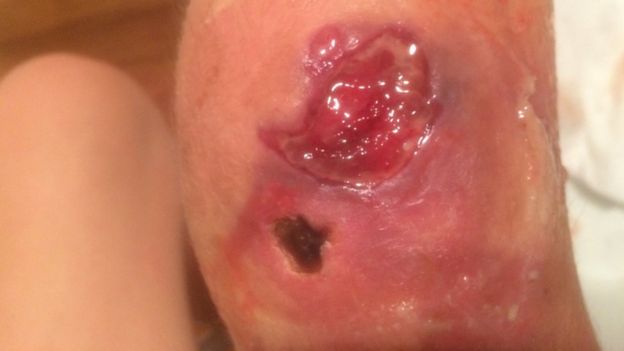A Brief Colonial History Of Ceylon(SriLanka)
Sri Lanka: One Island Two Nations
A Brief Colonial History Of Ceylon(SriLanka)
Sri Lanka: One Island Two Nations
(Full Story)
Search This Blog
Back to 500BC.
==========================
Thiranjala Weerasinghe sj.- One Island Two Nations
?????????????????????????????????????????????????Tuesday, September 26, 2017
Australian schoolgirl raises alarm over flesh-eating disease




Cases of a flesh-eating disease have rapidly increased in parts of Victoria (File photo)
21 September 2017
An Australian schoolgirl suffering from a flesh-eating ulcer is calling
for better government funding for research into the infectious disease.
Ella Crofts, 13, is slowly recovering from a Buruli ulcer, a skin disease usually found in the developing world.
Her case has prompted doctors to warn of a growing epidemic in area of Victoria state where she lives.
Health authorities there have recorded 159 cases of the infection in the year to September.
That is nearly three times the number of cases recorded three years ago.
Experts do not know how to prevent the disease nor how it is contracted.
WARNING: Graphic image below
Ms Croft, from the town of Tyabb, says her case began in April, with a sore knee that deteriorated into an open wound.
"Slowly it got worse, with my knee becoming swollen and inflamed, until
one day, the skin started breaking down," she said in a statement
online.
The outdoors-loving teenager said dry swab tests failed to pick up any
bacteria, and antibiotics for common infection also didn't stop her knee
worsening.
Her doctor, infectious disease expert and Associate Prof Daniel O'Brien
at the Geelong and Royal Melbourne hospitals, told the BBC that Ella had
suffered a severe case of Mycobacterium Ulcerans disease or Buruli ulcer.
"The bacteria gets under the skin and slowly eats its way through the
skin and the tissue underneath a limb until it's treated. The longer you
leave it the worse it gets, it's a progressive, destructive infection."
Ella has had three operations and months of powerful antibiotics to treat the destructive infection.
"I've had six months of quality medical care and still have not recovered," she said.
What is the Buruli ulcer?
- A skin disease caused by the bacterium Mycobacterium ulcerans.
- The bacteria emits toxins that destroy skin cells, small blood vessels and the fat under the skin, leading to ulcers forming and skin loss.
- The ulcer gets bigger with time and can lead to permanent disfigurement or disability.
- Usually affects limbs but can also be found on the face and body.
- Doctors do not know how the disease is transmitted to humans but it's believed to arise from the environment and soil.
- There are also theories that mosquitoes can carry the bacteria.
The teenager has set up a petition calling on federal and state government to increase research into the disease.
"Why are the numbers in Victoria increasing so rapidly? Why is it
moving? It used to be common on the Bellarine peninsula, now it's mostly
on the Mornington Peninsula," she wrote in her petition.

The Buruli ulcer attacking Ella's knee
Associate Prof O'Brien told the BBC there was a "worsening epidemic" in coastal Victoria.
"The cases are rapidly increasing, they seem to be doubling every year,
and we're getting twice as many severe cases than we used to, maybe
because the organism is growing more virulent," he said.
He was also concerned that the disease was popping up in different
areas, and said health authorities had limited knowledge of how to
intervene.
Victoria's Department of Health said it was studying local possum faeces
for traces of the bacteria and providing funding for studies into
mosquitoes.
It is also working with the Royal Australian College of General
Practitioners to develop training guides for doctors to help them
diagnose the disease quicker.
In Australia, cases of Buruli ulcers are most common in localised
coastal areas of Victoria. It has also been diagnosed in the tropical
regions of Queensland.
It is more commonly found in rural West Africa, Central Africa, New Guinea, Latin America and tropical regions of Asia.
